Overview
The article titled "7 Essential Tips for the Evidence Intake Center VA Process" aims to guide veterans in effectively navigating the VA claims process. We understand that this journey can be overwhelming, and it’s essential to have the right support. This article emphasizes the importance of:
- Thorough documentation
- Proactive communication
- Understanding the submission requirements
By focusing on these key areas, veterans can enhance their chances of achieving a successful outcome in their disability claims. Remember, you are not alone in this journey; we’re here to help you every step of the way.
Introduction
Navigating the complexities of the VA claims process can often feel like an uphill battle for veterans seeking the benefits they rightfully deserve. We understand that this journey can be overwhelming, especially with the VA's Evidence Intake Center playing a pivotal role in managing disability requests. By understanding its functions and best practices, you can significantly enhance your chances of a successful application.
However, with the stakes so high and the process fraught with potential pitfalls, it's common to feel uncertain. How can you effectively streamline your experience and avoid common mistakes? This article delves into essential tips and strategies that empower you to navigate the Evidence Intake Center with confidence. We're here to ensure you receive timely updates and support throughout your journey.
Turnout: Streamline Your VA Claims Process with AI-Powered Advocacy
We understand that navigating the VA application process can be overwhelming. Turnout is here to transform this experience by incorporating AI technology, making it easier for you to access the government benefits you deserve. With Jake, our AI case quarterback, experienced professionals are able to provide quicker onboarding, effective document organization, and proactive follow-ups that keep you informed every step of the way.
This modern approach not only lightens the administrative load but also enhances communication, ensuring that you receive updates throughout your application process. It’s common to feel anxious about waiting, but the application of AI has led to significant improvements. For instance, the average wait time for a military service member's request has decreased from 141.5 days to 131.8 days in just a few months.
By utilizing AI, Turnout aims to turn the traditionally cumbersome process into a more manageable and user-friendly experience for individuals like you seeking benefits. This commitment is exemplified by the VA's record processing of over 2 million disability requests in fiscal 2025. Together, we can harness the power of technology to accelerate and enhance service delivery for those who have bravely served our country. Remember, you are not alone in this journey; we’re here to help.
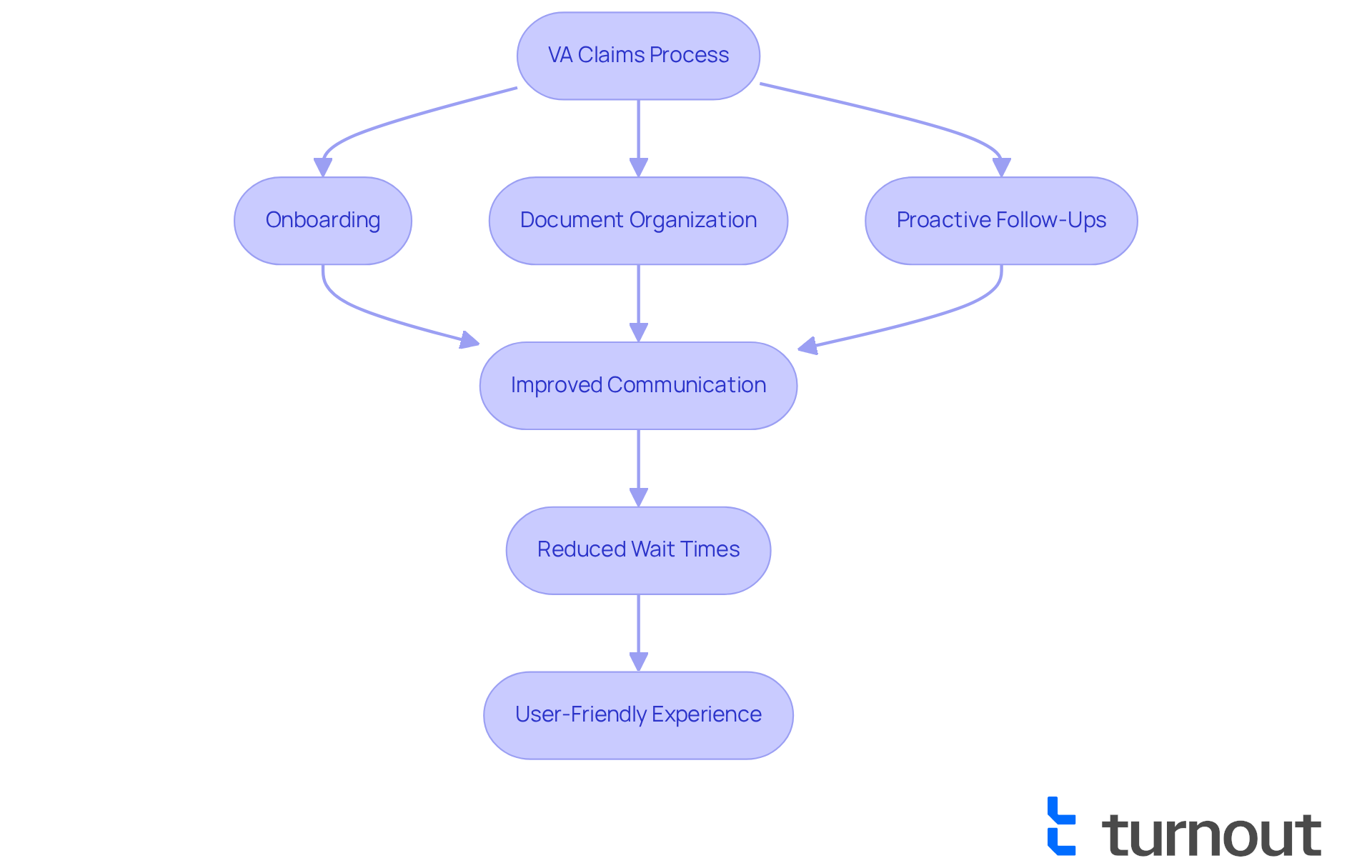
Understanding the VA Evidence Intake Center's Role in Disability Claims
The evidence intake center va is here to assist former service members like you in navigating the complexities of disability requests. As the primary facility for handling these requests, the evidence intake center va plays a vital role in the benefits system by ensuring that all documents related to your applications—initial submissions, supporting evidence, and supplementary materials—are received, sorted, and digitized efficiently. This streamlined approach aims to enhance both effectiveness and precision, ultimately providing you with a smoother experience.
We understand that managing your requests can feel overwhelming. With the VA processing over 2 million disability benefits requests in fiscal year 2025, the importance of an efficient system cannot be overstated. Encouragingly, the average wait time for processing a veteran's request has decreased from 141.5 days to 131.8 days between January and June 2025. This progress reflects ongoing improvements that benefit you.
Expert insights highlight the role of the evidence intake center va in expediting requests. As John Fanning, a DAV Chapter Commander, points out, addressing issues promptly through the right channels can significantly impact the outcome of your request. The evidence intake center va's organized approach not only facilitates quicker processing but also ensures that you receive the benefits you have earned without unnecessary delays. By utilizing the resources at the evidence intake center va, you can enhance your chances of successful application processing and navigate the VA system with greater confidence.
Remember, you are not alone in this journey. We’re here to help you every step of the way.
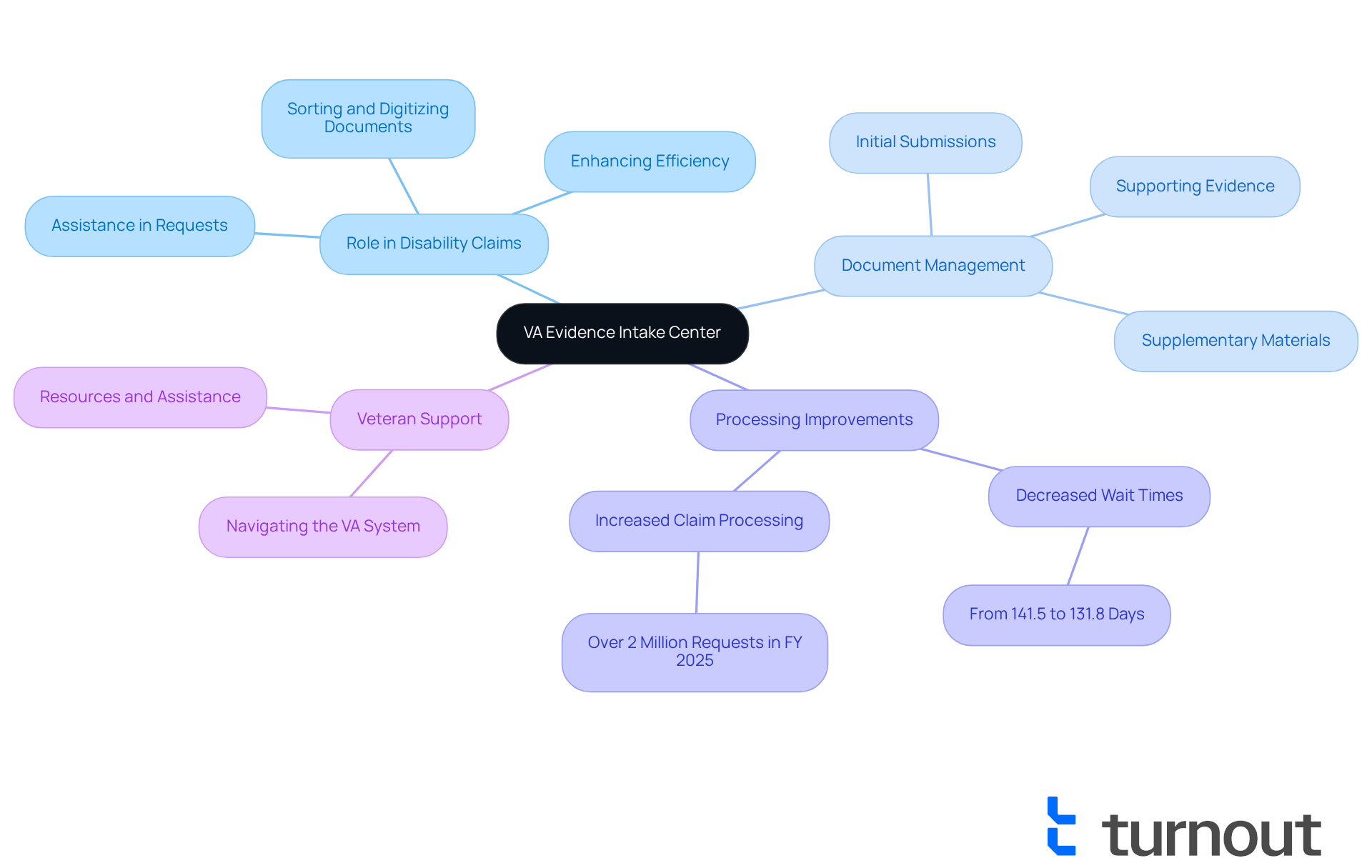
Common Reasons for VA Evidence Intake Center Communication with Veterans
Veterans, we understand that receiving correspondence from the evidence intake center VA can feel overwhelming. You might get letters requesting additional evidence, updates on your submissions, or information about changes in VA procedures. These communications often arise from incomplete applications, missing documentation, or the need for clarification on submitted materials.
It's important to know that the review process for VA evidence typically takes about 125 days, and appeals can stretch from several months to as long as 7 years. This underscores the need for thoroughness in your submissions. By understanding these factors, you can take proactive steps in managing your requests, ensuring you provide all essential details to avoid unnecessary delays.
Effective communication with the evidence intake center VA can significantly enhance the handling of your disability requests, leading to more timely and favorable outcomes. Remember, as one source highlights, "If you get a letter from the VA Evidence Intake Center, don’t throw it away! They could be telling you important things about your benefits."
To further prevent delays, please ensure that all paperwork is tagged with your full name, Social Security number, and date of birth. The evidence intake center VA is dedicated to processing only disability compensation requests and pension requests, and providing complete information helps them serve you better. You are not alone in this journey—we're here to help you navigate through it.
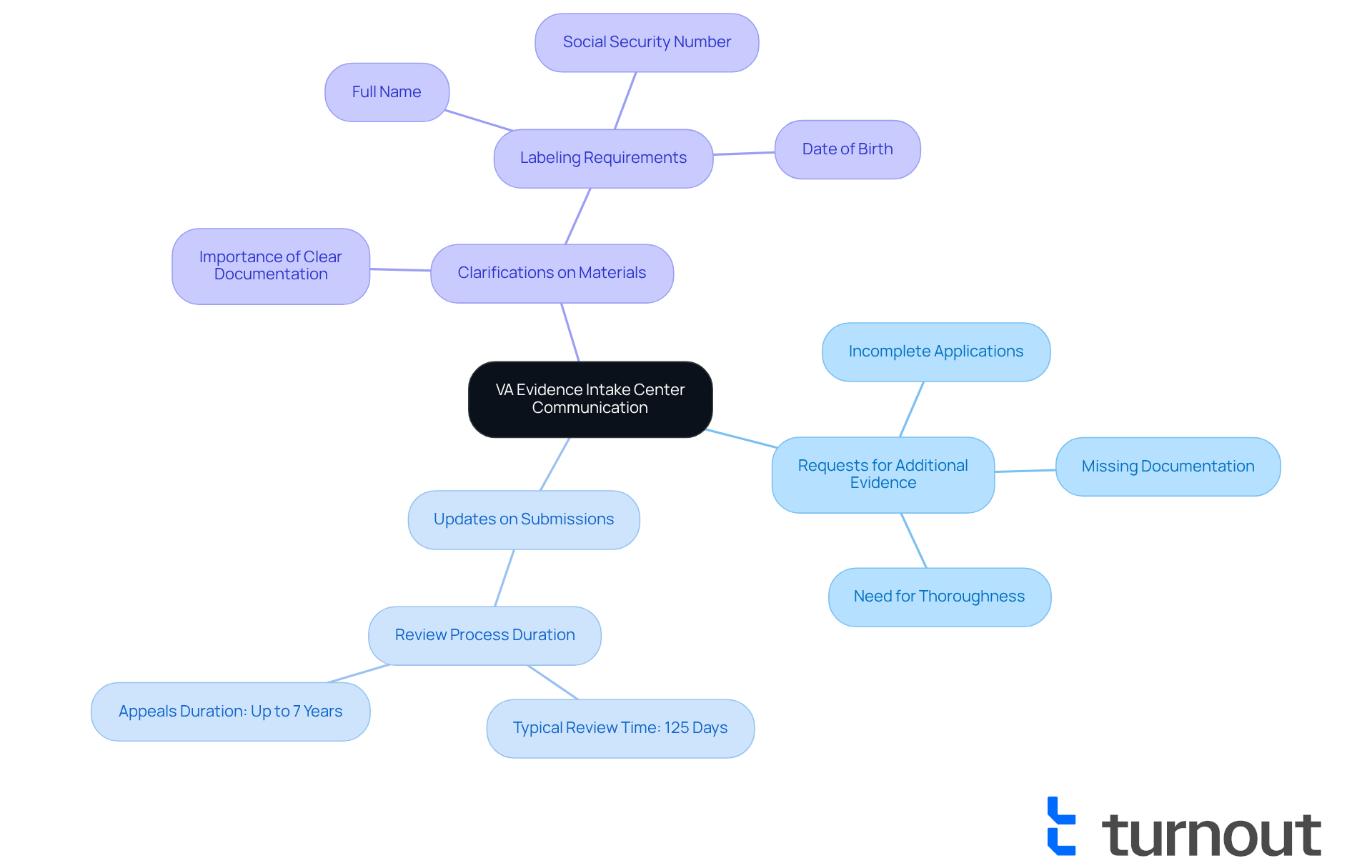
Steps to Take After Receiving a Letter from the VA Evidence Intake Center
Receiving a letter from the evidence intake center VA can feel overwhelming. We understand that navigating the claims process is not easy, and we're here to help you through it. Start by reading the letter thoroughly to grasp its contents and any specific requests.
Next, gather the required documents or information requested. Respond promptly, ensuring that all submissions are thorough and precise. Keeping a detailed record of all correspondence with the evidence intake center VA is crucial. Note the dates and specifics of what you sent; this will aid in your organization and serve as a helpful reference in the future.
Be mindful that sending extraneous documents can delay the processing of your disability benefits application. If the letter suggests additional actions are needed, prioritize these tasks to sustain the progress of your request. Remember, effective communication—being strategic, prompt, and clear—can significantly enhance your chances of a successful outcome.
It's common to feel anxious about the timeline, so be aware that the typical review process for claims takes about 125 days. Staying proactive is essential, and you are not alone in this journey.
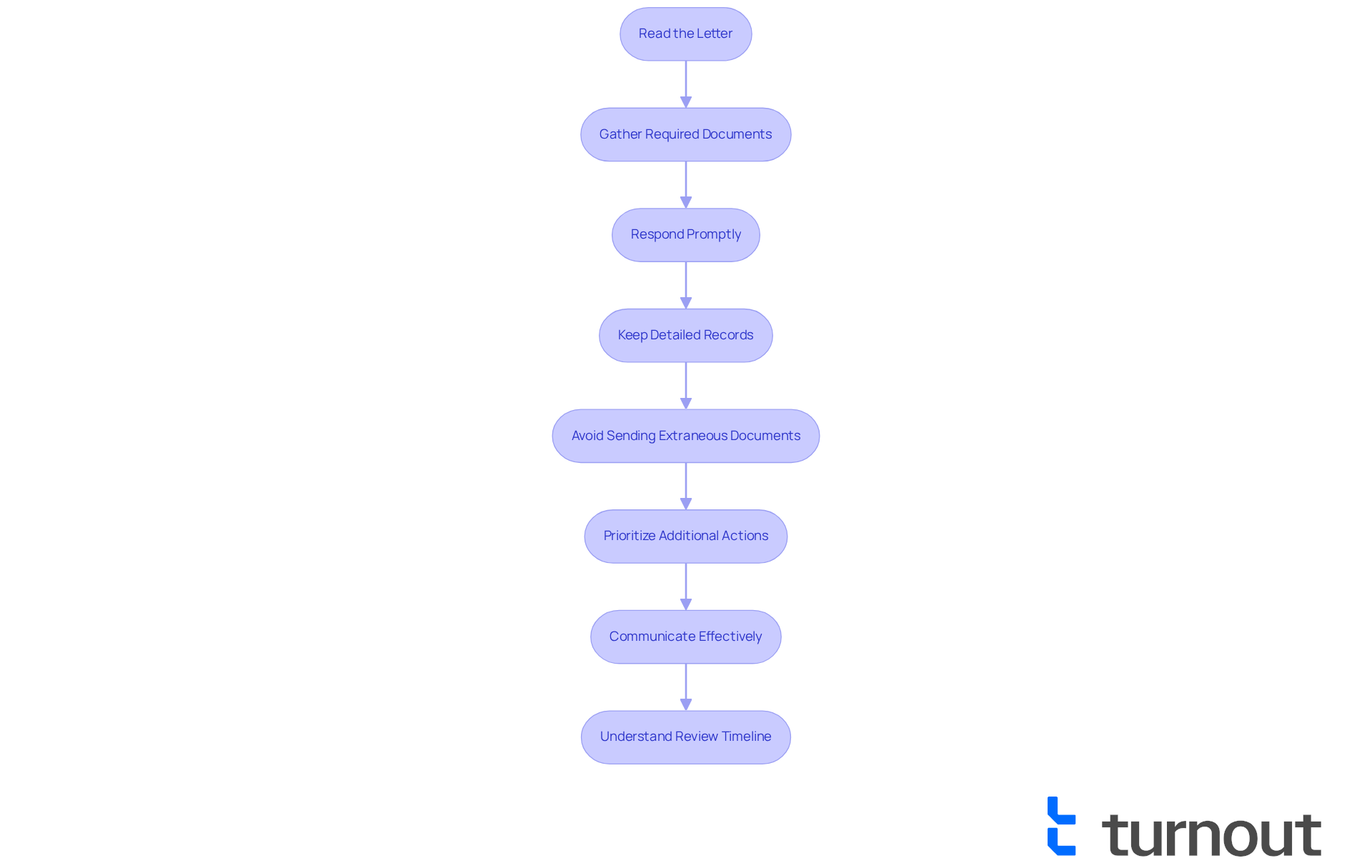
Best Practices for Submitting Documents to the VA Evidence Intake Center
To ensure successful document submission to the evidence intake center VA, we understand that veterans face many challenges. Here are some essential best practices to help you navigate this process with confidence:
- Always make copies of all documents before sending them. This way, you maintain a record of your submissions. As Chris Attig emphasizes, "You cannot prove what you sent to the VA unless you keep an exact copy of everything you send."
- Utilize certified mail or secure electronic submission methods, such as QuickSubmit. This allows you to monitor your materials effectively. QuickSubmit not only simplifies the submission process but also maintains a record of uploads, reducing the likelihood of errors.
- Clearly label each file with your full name, Social Security number, and claim number. This simple step can help avoid processing delays. Attig recommends that having this information ensures your files arrive at the appropriate Regional Office more swiftly.
- Refrain from sending original materials unless explicitly requested. Sending originals may result in loss or damage. Attig cautions, "Don’t ever send your original version of a paper, and don’t ever send your ONLY version of a paper."
- Ensure that all records for the evidence intake center VA are complete and organized. This helps facilitate efficient processing by the evidence intake center VA. The EIC has handled millions of files, and keeping things organized can greatly accelerate the evaluation procedure.
By following these strategies, you can significantly decrease the chances of requests being postponed due to document submission errors. This, in turn, improves your likelihood of a prompt and successful process. Remember, you are not alone in this journey. Send all correspondence for compensation requests to the evidence intake center VA, PO Box 4444, Janesville, WI 53547-4444.
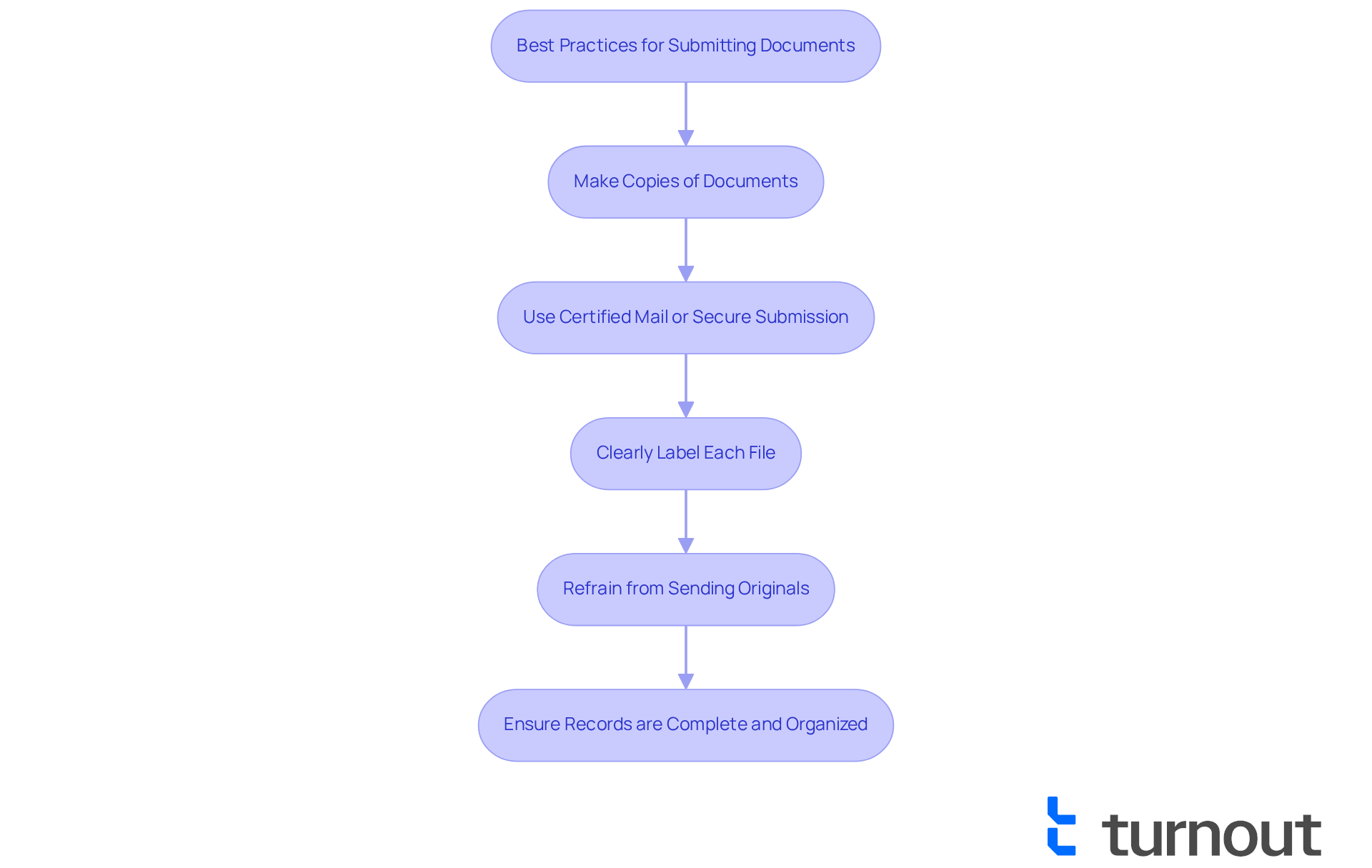
Importance of Ongoing Communication with the VA Evidence Intake Center
Sustaining regular communication with the evidence intake center VA is crucial for former service members as they navigate their applications. We understand that managing these processes can be challenging. By frequently monitoring the status of requests and swiftly addressing any inquiries, veterans can greatly improve the efficiency of their experience. This proactive involvement not only keeps you updated but also empowers you to recognize and tackle potential problems before they escalate, resulting in a more seamless journey.
Veterans who actively engage with the VA often report better outcomes. For instance, those who regularly pursue their requests are more likely to receive prompt updates and avoid unnecessary delays. Interacting with the VA through their online portal or by phone can provide valuable insights into the status of requests and any further documentation needed.
Experts emphasize that effective communication is essential in speeding up processing times. As Alex Horton notes, "Claims go faster if they have accurate and complete information." We encourage veterans to utilize available resources, such as instructional videos provided by the VA, to better understand how to navigate the system and maintain open lines of communication. It's important to acknowledge that the development stage of the requests procedure can take approximately 100 days, highlighting the necessity for continuous communication.
Numerous instances exist of former service members who have successfully managed their requests by staying in touch with the VA. For example, Charles P. Lamont faced considerable delays in his application process, underscoring the significance of communication in overcoming these challenges. Another veteran shared that routine check-ins helped clarify the criteria for their disability request, ultimately leading to a faster resolution. Documenting all interactions with the VA can also serve as a helpful reference if any discrepancies arise.
To ensure effective communication with the evidence intake center VA, service members should log in to VA.gov, navigate to 'VA Benefits and Health Care,' select 'Disability,' and check their status regularly. This method not only encourages transparency but also empowers former service members to engage actively in their application journey. Remember, you are not alone in this process; we’re here to help you every step of the way.
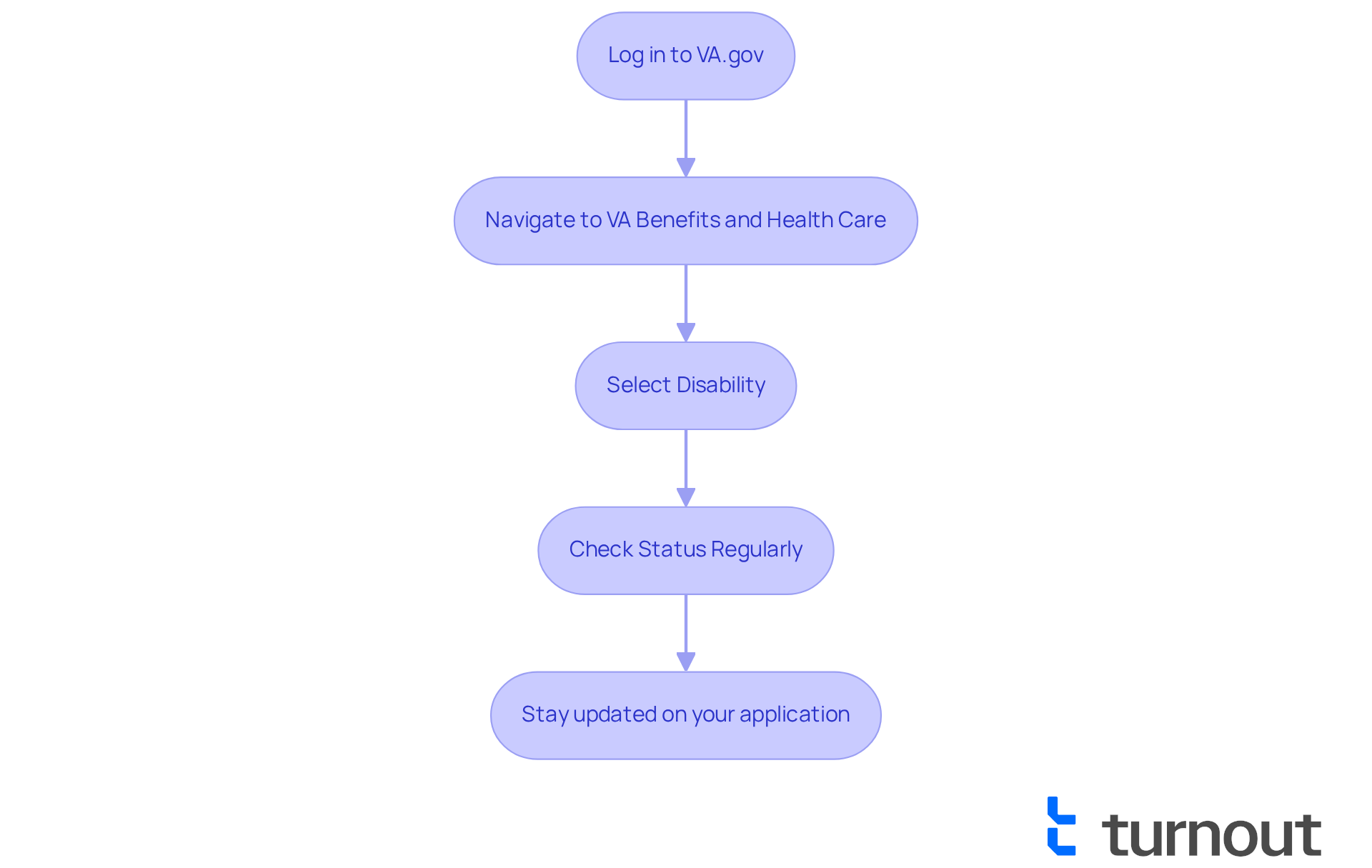
What Not to Send to the VA Evidence Intake Center: Avoiding Common Mistakes
Veterans, we understand that navigating the evidence intake center VA can be daunting. It's essential to exercise caution regarding what you send. Common pitfalls include:
- Sending original materials that may be misplaced
- Submitting incomplete forms or missing signatures
- Not providing enough proof to support your claims
Additionally, it's important to avoid submitting irrelevant documents that do not directly relate to your requests, such as:
- Personal letters
- Unrelated medical records
This can complicate the review process and lead to unnecessary delays. Statistics show that around 30% of requests are denied due to submission errors. This highlights the need for careful attention to detail.
By being mindful of these potential pitfalls, you can streamline your submissions to the evidence intake center VA. Remember, you are not alone in this journey; we’re here to help you enhance your chances of a favorable outcome.
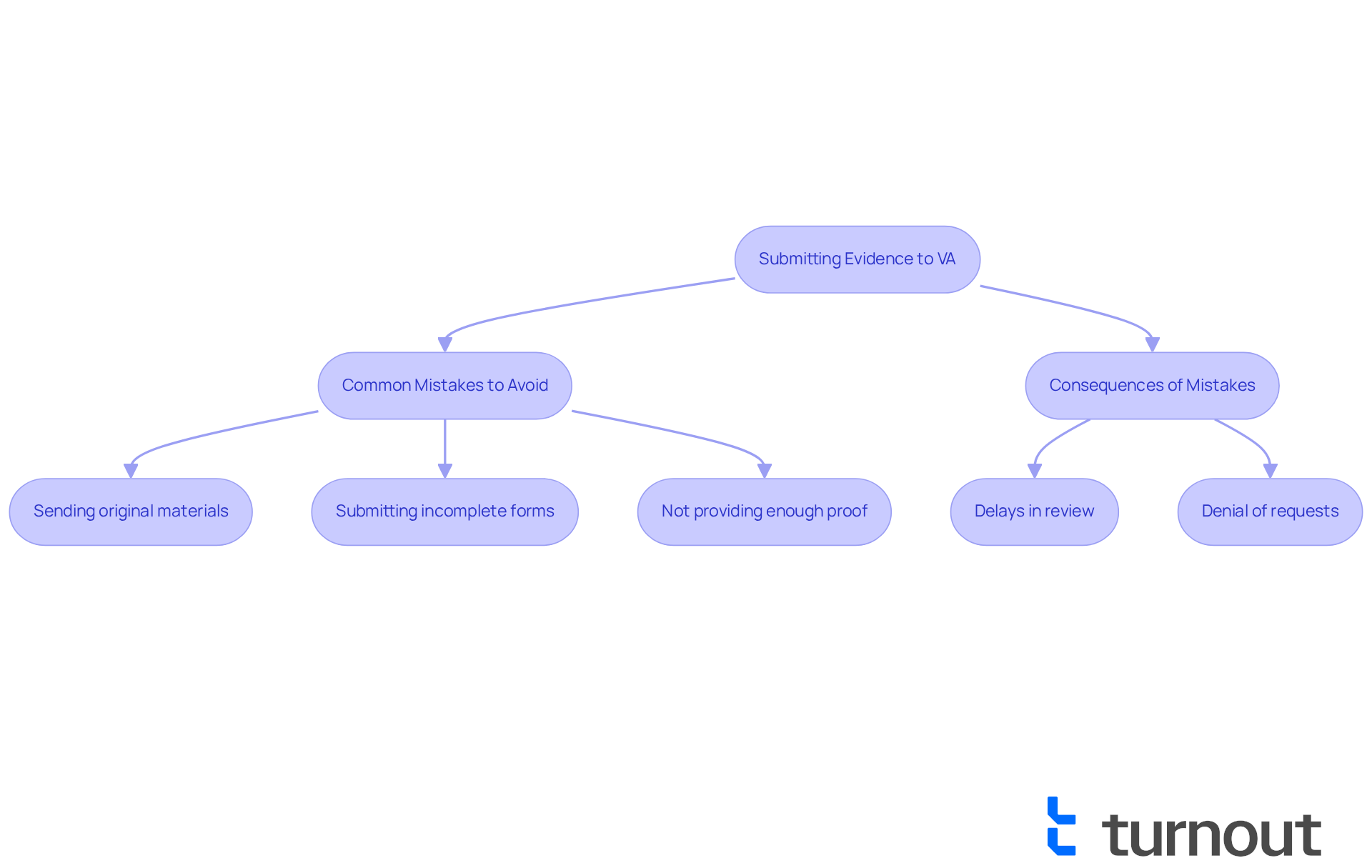
Documents Typically Requested by the VA Evidence Intake Center
Navigating the disability application process can be challenging, and at the evidence intake center VA, we understand that you may have many questions. To help you along this journey, several important records are typically requested to process your disability application. These may include:
- Your DD214 or other separation papers
- Medical records that support your claimed disability
- Service treatment records
- Any relevant lay statements or buddy letters
Additionally, it’s important to remember that former service members may need to submit VA documents that validate their requests, such as the Application for Disability Compensation (VA Form 21-526EZ). Having these materials ready can significantly speed up the claims process. We encourage you to make duplicates of all documents before submission to prevent the loss of original files.
To ensure your documents reach us safely, consider using certified mail for submission. This not only provides delivery verification but also helps avoid any misdelivery. Including personal evidence can further strengthen your claim by offering testimonies that affirm your condition. When submitting documentation, please ensure that your envelope is clearly marked with your name.
Familiarizing yourself with the evidence intake center VA's submission guidelines can assist you in navigating this process more effectively and help prevent unnecessary delays. Remember, you are not alone in this journey, and we are here to help you every step of the way.
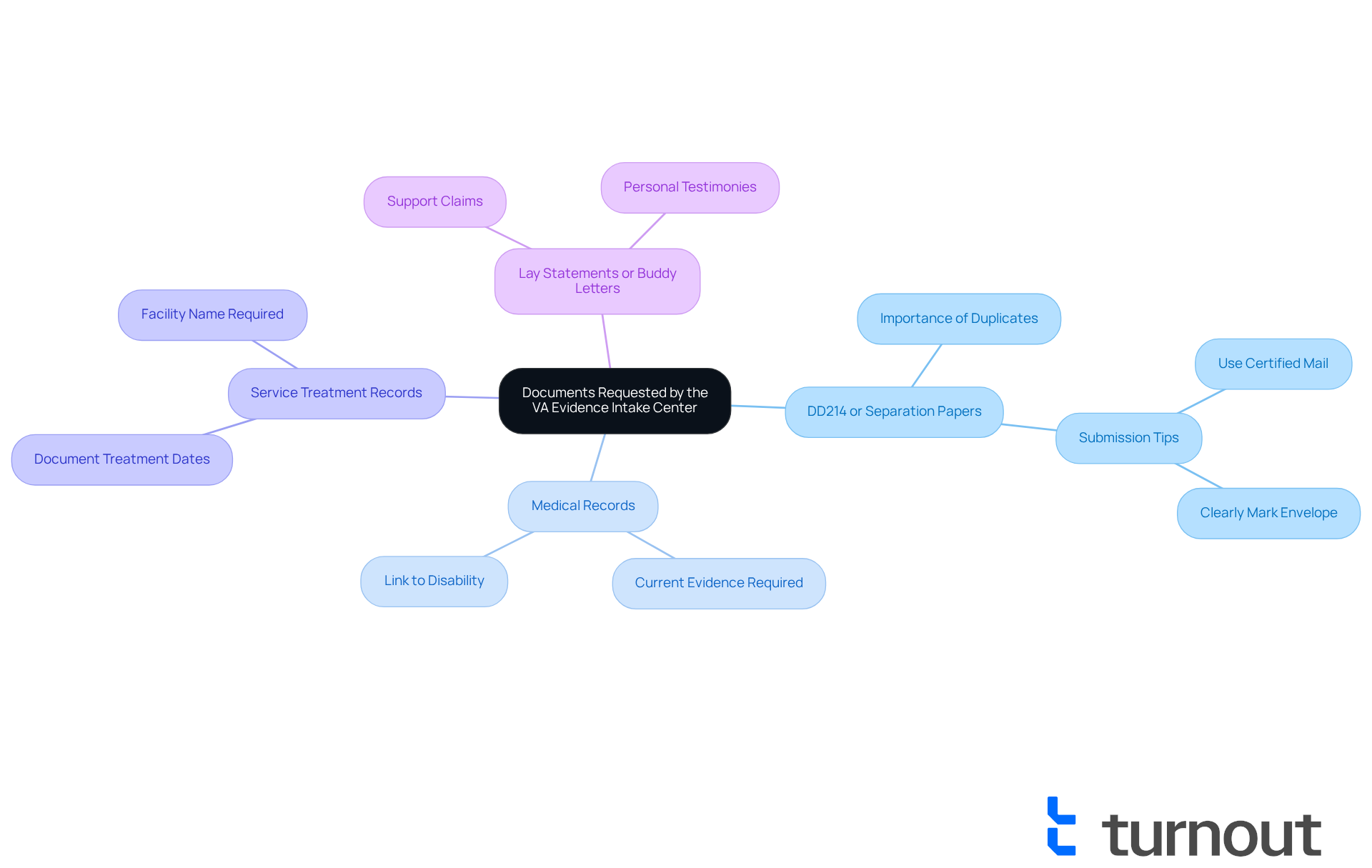
Expected Timeline After Submitting Evidence to the VA Evidence Intake Center
After submitting evidence to the evidence intake center VA, veterans can typically expect a processing timeline ranging from several weeks to a few months. We understand that this period can feel daunting, as it mainly relies on the intricacy of your requests and the volume of submissions being managed by the Center.
You should receive an acknowledgment of your submission within approximately 10 business days. Following this, updates on the status of your requests will be communicated as the evidence intake center VA reviews the evidence. It's common to feel anxious during this waiting period, especially considering that the typical processing duration for disability-related requests is around 100 days. We encourage service members to remain patient during this time.
Please remember that Turnout is not a legal organization and does not offer legal counsel. Instead, we employ trained non-professional advocates who are here to help former service members manage their applications. If you don’t receive communication within the expected timeframe, we encourage you to follow up to ensure your requests are moving forward. You are not alone in this journey; Turnout can assist you with our expert guidance and tools designed to simplify access to government benefits.
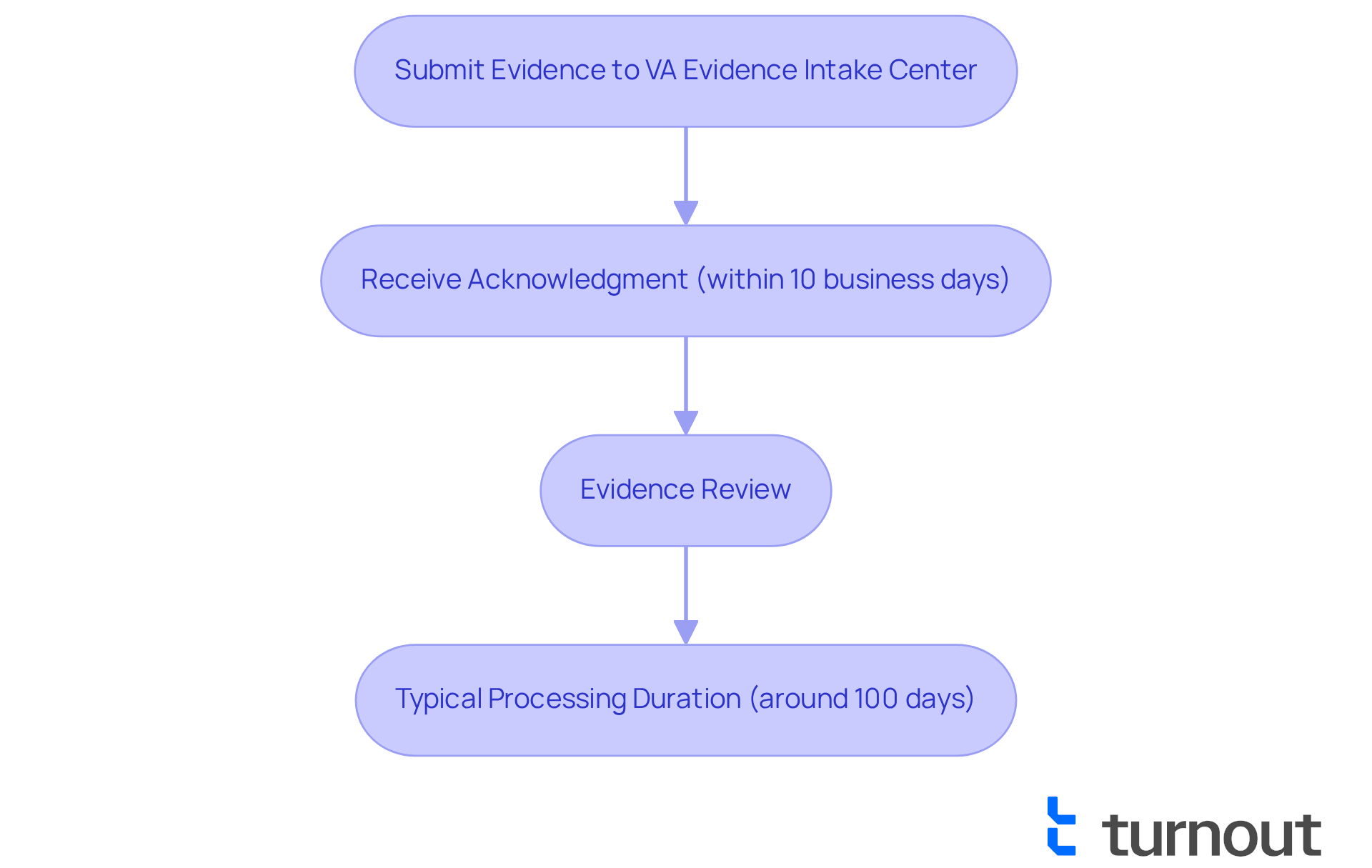
Frequently Asked Questions About the VA Evidence Intake Center
Veterans often have questions about the evidence intake center va. You might wonder: What should I do if I receive a letter from the EIC? How long will it take to process my claim? What documents do I need to submit? We understand that navigating these concerns can be overwhelming. To effectively address these questions, it’s crucial to carefully read all correspondence from the evidence intake center va and respond promptly to any requests for information.
Common letters from the evidence intake center va may include:
- Requests for additional evidence
- Updates on the status of claims
- Decisions regarding claims
Keeping a detailed record of your submissions is essential for tracking progress. We recommend using certified mail for your submissions to ensure you have proof that your documents were sent.
For specific inquiries, you can reach out to the evidence intake center va directly via their designated phone numbers or visit the VA's official website for further assistance. Comprehending these communications can greatly improve how requests are handled and enhance your results. Additionally, maintaining organized files of all documents sent to and received from the evidence intake center va is a key practice for effective claims management. Remember, you are not alone in this journey; we are here to help.
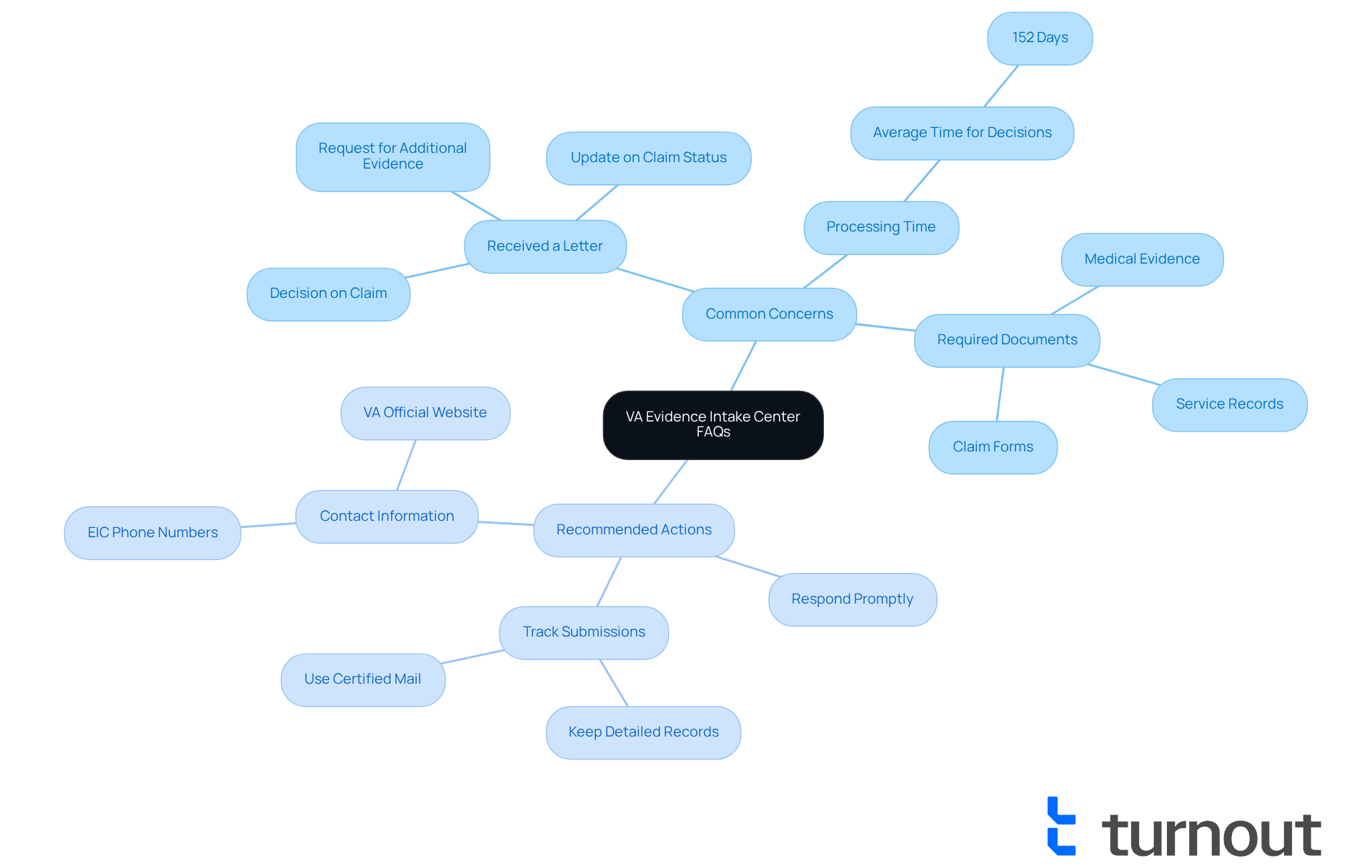
Conclusion
Navigating the VA claims process can feel overwhelming. However, understanding the role of the Evidence Intake Center and leveraging modern technology can make this journey much smoother. With AI-powered advocacy, like what Turnout offers, the process becomes more efficient and user-friendly for veterans seeking the benefits they have earned.
Key insights from this article highlight the necessity of:
- Thorough documentation
- Proactive communication
- Awareness of the timelines involved in the claims process
By following best practices for document submission and maintaining regular contact with the Evidence Intake Center, veterans can significantly enhance their chances of a successful outcome. It's also crucial to be mindful of common pitfalls, such as:
- Submitting original documents
- Incomplete applications
To avoid unnecessary delays.
Ultimately, you don't have to face the VA claims process alone. By utilizing available resources, engaging with the Evidence Intake Center, and embracing technological advancements, veterans can navigate this complex system with greater confidence. Remember, staying proactive and informed is vital—each step brings you closer to receiving the benefits you truly deserve.
Frequently Asked Questions
What is Turnout and how does it help with VA claims?
Turnout is a service that utilizes AI technology to streamline the VA claims process, making it easier for individuals to access government benefits. It offers quicker onboarding, effective document organization, and proactive follow-ups through an AI case quarterback named Jake.
How has AI impacted the VA claims processing time?
The application of AI has reduced the average wait time for military service members' requests from 141.5 days to 131.8 days in just a few months, significantly improving the efficiency of the claims process.
What is the role of the VA Evidence Intake Center?
The VA Evidence Intake Center is responsible for handling disability requests from former service members. It ensures that all documents related to applications are received, sorted, and digitized efficiently, enhancing the overall effectiveness and precision of the benefits system.
How many disability benefits requests did the VA process in fiscal year 2025?
The VA processed over 2 million disability benefits requests in fiscal year 2025, highlighting the importance of an efficient system in managing such a high volume of applications.
What should veterans do if they receive communication from the evidence intake center?
Veterans should not disregard any letters from the evidence intake center, as they may contain important information about their benefits or requests for additional evidence. Effective communication can lead to more timely and favorable outcomes.
How long does the review process for VA evidence typically take?
The review process for VA evidence typically takes about 125 days, while appeals can take several months to as long as 7 years.
What information should be included on all paperwork submitted to the evidence intake center?
All paperwork should be tagged with the veteran's full name, Social Security number, and date of birth to help the evidence intake center process the requests more efficiently.
What types of requests does the evidence intake center VA process?
The evidence intake center VA is dedicated to processing only disability compensation requests and pension requests.




